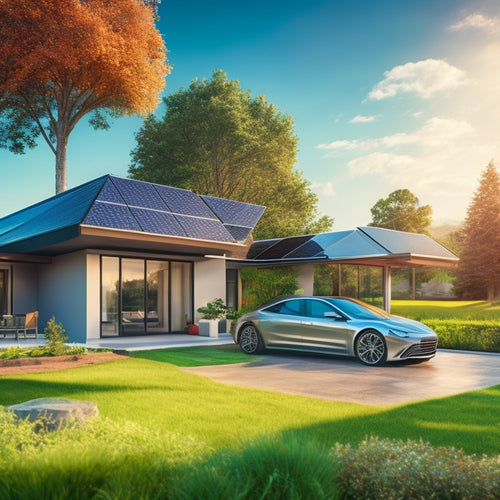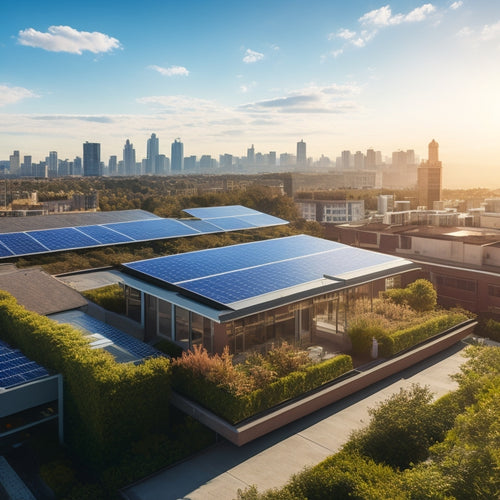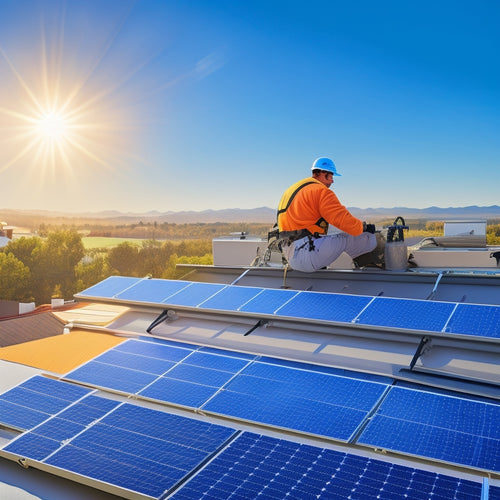
How Much Does Solar Power Cost
Share
You're likely to spend between $15,000 and over $50,000 on a solar power system, with a national average around $30,000. The final cost depends on factors like system size, technology, and installation complexity, as well as financing options, such as outright purchase, loan financing, or Power Purchase Agreements. Understanding the different types of solar panels, inverters, and battery storage can help you make informed decisions. As you manage the various components and pricing, you'll want to reflect on local incentives, maintenance costs, and long-term benefits to get a clear illustration of your solar power investment's true value.
Key Takeaways
- The national average cost of a solar system is around $30,000, with prices ranging from $15,000 to over $50,000.
- Installation fees vary from $2,000 to $10,000 based on complexity, with commercial installations ranging from $2.50 to $5.00 per watt.
- Financing options include outright purchase, loan financing, and Power Purchase Agreements (PPAs), which allow for manageable monthly payments.
- The cost per energy unit decreases with larger system sizes, but must be evaluated against energy needs and available space.
- System size, location, and technology type significantly influence overall expenses, with incentives and rebates available to reduce upfront costs.
Understanding Solar Panel Costs
As you contemplate shifting to solar power, understanding the costs associated with solar panels is essential. You'll need to decide which type of solar panel suits your needs, as different types have varying price points. Monocrystalline silicon panels, for instance, are more expensive than polycrystalline silicon panels. Thin-film panels are another option, offering a more affordable alternative.
When calculating the total cost, you'll need to factor in installation fees, which can range from $2,000 to $10,000, depending on the complexity of the installation. Additionally, you may need to take into account additional expenses, such as inverters, mounting systems, and electrical connections.
Fortunately, various financing options are available to help make solar power more accessible. You can choose from outright purchase, loan financing, or power purchase agreements (PPAs), which allow you to pay for the electricity generated rather than the panels themselves.
Factors Affecting Solar Pricing
When you're evaluating solar power costs, you'll find that several factors influence the final price tag.
You'll need to take into account the system size, as larger systems typically reduce the cost per unit of energy produced.
Additionally, your location and the type of technology you choose will also impact the overall cost of your solar power system.
System Size Matters
Determining the ideal solar panel system size for your property is vital in optimizing energy production and minimizing costs.
You'll want to take into account your energy usage, available roof space, and local building codes to determine the right size for your system. A larger system will increase energy output, but it may not be necessary or even possible for your property.
A system that's too small won't meet your energy needs, while one that's too large may not be cost-effective. You should also evaluate system efficiency, as a more efficient system will produce more energy per hour of sunlight.
Your installation timelines, financing options, and grid connection requirements will also impact the size of your system. Additionally, if you're thinking about battery storage, this will affect your system size as well.
Proper maintenance tips and understanding the environmental impact of your system are essential. Look for a system with an extensive warranty to guarantee your investment is protected.
Location Affects Cost
You've optimized your system size, now it's time to evaluate the impact of location on your solar power cost. The location of your solar panel installation greatly affects the overall cost.
Regional pricing varies depending on the state or region you're in, with some areas having higher installation costs than others. Climate impact is another vital factor, as areas with high temperatures or extreme weather conditions may require additional installation materials or specialized equipment, increasing costs.
Market demand also plays a role, with areas having high demand for solar power often resulting in higher prices. However, local incentives, such as tax credits or rebates, can help offset these costs.
Installation regulations, utility rates, and environmental factors, like shading or roof size, also influence the final cost. State policies, such as renewable portfolio standards or net metering laws, can further impact the cost of solar power.
Understanding these location-specific factors will help you better estimate the cost of your solar power system.
Technology Type Varies
The type of solar technology you choose plays a significant role in shaping your overall solar power cost. You'll need to evaluate factors like panel efficiency, which can range from 15% to over 22%. Higher-efficiency panels may cost more, but they'll generate more power per hour of sunlight.
Inverter types also vary, with string inverters being the most common, but power optimizers and microinverters offering more flexibility. If you're looking for energy independence, you might opt for battery storage, which can add $5,000 to $15,000 to your upfront cost.
Grid integration is another factor, as it allows you to sell excess energy back to the grid. Off-grid solutions, on the other hand, provide independence from the grid but often require more equipment.
Solar tracking systems can enhance energy production by up to 45%, but they'll add to your overall cost. When assessing your options, reflect on the environmental impact and installation innovations that can reduce your costs.
Average Cost of Solar Systems
Solar systems' prices vary widely depending on several factors, including their size, quality, and installation location. You'll need to take into account these variables when evaluating the average cost of solar systems for your energy independence.
The overall cost of a solar system can range from $15,000 to over $50,000, with the national average hovering around $30,000. However, with solar financing options, you can break down the cost into manageable monthly payments.
Beyond the upfront cost, think about the long-term environmental benefits and energy efficiency of solar power. You'll be contributing to grid stability and reducing your reliance on fossil fuels.
Don't believe solar myths – with proper installation and maintenance, a solar system can last for over two decades, backed by system warranties. Additionally, government policies offer incentives for adopting solar energy.
When planning your solar installation, factor in installation timelines, which can vary from a few weeks to several months, depending on the complexity of your project.
Residential Solar Power Prices
As residential solar power gains popularity, understanding the pricing fluctuations becomes essential for homeowners. You're likely wondering how much it'll cost to utilize the sun's energy for your home. The good news is that residential solar power prices have dropped considerably over the years, making it a more accessible option.
When considering residential solar power, you'll want to factor in the following key cost components:
-
System size and quality: The number of solar panels and their efficiency will impact your overall cost.
-
Installation costs: Labor, permits, and equipment costs vary depending on your location and installer.
-
Roof size and condition: A larger roof or one requiring repairs may increase your costs.
- Solar financing options: You may be able to take advantage of financing options, such as loans or power purchase agreements, to reduce upfront costs.
With the right system and financing, you can enjoy the energy independence benefits of solar power.
Commercial Solar Power Costs
You're likely to find that commercial solar power costs are considerably higher than residential systems, mainly due to larger system sizes and more complex installations.
When evaluating commercial solar power costs, you'll need to take into account both system installation costs, which can range from $2.50 to $5.00 per watt, and ongoing system maintenance expenses, which typically add up to $1,000 to $2,000 per year.
Understanding these costs will help you determine whether commercial solar power is a viable option for your business.
System Installation Costs
Several factors influence the overall system installation costs of commercial solar power, but the most notable ones are the system size, equipment quality, and installation complexity.
When you're planning to install a commercial solar power system, you need to take into account these factors to get an accurate estimate of the costs involved.
Here are 4 key aspects that impact system installation costs:
-
System design and installation timeline: A well-designed system with a shorter installation timeline can reduce labor costs and minimize disruptions to your business operations.
-
Financing options and contractor selection: Your choice of financing options and contractor can greatly affect the overall cost of the system. Look for contractors who offer competitive pricing and financing options that fit your budget.
-
Local regulations and installation permits: Compliance with local regulations and obtaining necessary installation permits can add to the overall cost of the system.
- Equipment quality and warranty coverage: High-quality equipment with thorough warranty coverage can provide long-term savings and reduce maintenance costs.
Additionally, you'll need to take into account labor costs, grid connection, and other expenses when calculating the total system installation cost.
System Maintenance Expenses
Commercial solar power systems require regular maintenance to secure peak performance and extend their lifespan. As a commercial solar power system owner, you'll need to budget for routine maintenance expenses to guarantee maximum energy production.
Regular solar panel cleaning is essential to maintain system efficiency, and you can expect to pay around $300 to $1,000 per year, depending on the system size and cleaning frequency. Inverter replacement is another significant maintenance expense, with costs ranging from $2,000 to $10,000 or more, depending on the inverter type and system size.
Fortunately, many commercial solar power systems come with warranty coverage, which can mitigate some of these costs.
To minimize maintenance frequency, think about investing in performance monitoring systems, which can detect issues early on. Troubleshooting issues promptly can prevent costly repairs down the line.
You may also want to think about service contracts, which can provide priority access to maintenance and repairs. Additionally, budget for occasional system upgrades to guarantee your system remains efficient and productive.
Solar Panel Installation Fees
When it comes to solar panel installation fees, the largest expense is typically attributed to the upfront cost of purchasing the solar panels themselves, which can account for nearly 50% of the total installation cost.
In addition to the panel cost, other significant expenses include the installation process itself, which can range from $2,000 to $15,000 or more, depending on the complexity of the installation and the location of your property.
You'll also need to take into account the cost of inverters, mounting hardware, and other components necessary for the system to function properly.
Here are some key factors that can impact your installation fees:
- System size: Larger systems require more panels, inverters, and hardware, increasing the overall cost.
- Roof complexity: Installations on complex or multi-level roofs can be more challenging and expensive.
- Local labor costs: Installation companies in urban areas or regions with high labor costs may charge more for their services.
- Financing options: You may need to take into account financing costs, such as interest rates and loan fees, if you're not paying cash upfront.
Understanding these factors can help you better estimate your solar panel installation fees and make informed decisions about your energy investment.
Incentives and Rebate Options
Opportunity knocks in the form of incentives and rebate options, which can greatly reduce the financial burden of going solar. You can take advantage of federal incentives, state rebates, and tax credits to offset the upfront costs of solar panel installation. Additionally, utility programs and financing options can help make solar power more accessible.
| Incentive Type | Description | Benefit |
|---|---|---|
| Federal Incentives | 26% tax credit for solar installation | 26% of total installation cost |
| State Rebates | Varying amounts by state, e.g., California's $0.95/Watt rebate | Up to $2,000 |
| Utility Programs | Net metering allows selling excess energy back to the grid | Varies by utility provider |
You may also be eligible for solar grants, community solar programs, and other local incentives. Be sure to research and investigate these options to maximize your savings. By combining these incentives, you can greatly reduce the cost of going solar and start generating clean energy for your home or business.
Long-Term Savings and ROI
By offsetting the upfront costs with incentives and rebates, you can now focus on the long-term benefits of going solar. As you invest in solar power, you'll enjoy a significant return on investment (ROI) through reduced energy bills and increased energy independence.
Here are 4 key advantages of going solar:
-
Future Savings: With solar power, you'll lock in a fixed energy rate for the next 25 years or more, protecting yourself from rising grid electricity prices.
-
Environmental Impact: By utilizing renewable energy, you'll reduce your carbon footprint and contribute to a cleaner environment.
-
Financial Incentives: You'll benefit from tax credits, financing options, and potential increases in your property value.
- Energy Efficiency: Solar power systems require minimal maintenance and can optimize your energy usage, ensuring grid reliability and efficiency.
As you consider your investment strategy, keep in mind that solar power is a smart long-term decision.
With market trends favoring renewable energy, you can expect a strong ROI and enjoy the benefits of energy independence for years to come.
Frequently Asked Questions
Can I Install Solar Panels Myself to Save Money?
Like a modern-day DIY MacGyver, you're tempted to install solar panels yourself to reap cost savings. While possible, it's vital to weigh the risks: improper installation can void warranties and compromise system efficiency, potentially offsetting any DIY installation cost savings.
Will Solar Panels Increase My Property Value?
You'll likely see an increase in property value with a solar investment, as a property appraisal will factor in the increased energy efficiency, resulting in a higher valuation, which can lead to a strong resale appeal.
Do Solar Panels Work During Power Outages?
You'll be glad to know that solar panels won't provide power during outages unless you have a battery backup system, which guarantees grid independence. However, a high-efficiency solar panel system can maximize energy production when the grid's online.
Can I Sell Excess Energy Back to the Grid?
You can sell excess energy back to the grid through net metering benefits, like California's energy buyback program, which credits you for surplus energy produced, as seen in the case of Google's Mountain View campus, which sells 30% of its excess energy back to the grid.
Are Solar Panels Recyclable at the End of Their Life?
You'll be pleased to know that solar panels are recyclable at the end of their 25-30 year lifespan, with recycling processes recovering up to 95% of materials, including silicon, aluminum, and glass, reducing waste and environmental impact.
Related Posts
-

What Solar Panels Work Best With EVS Online?
When shopping for solar panels online to power your electric vehicle, look for high-efficiency models that can withst...
-

What Is the Cost to Put in Solar Panels
You're likely considering solar panels for your home, and the most significant factor in your decision is the upfront...
-

3 Essential Steps for Solar Electricity Installation
To guarantee a successful solar electricity installation, you'll need to follow three essential steps. First, assess ...


